Rock climbing gares
- 1Rope, cord and webbing
- 2Carabiners
- 3Quickdraws
- 4Harnesses
- 5Belay devices
- 6Rappel devices (descenders)
- 7Ascenders
- 8Sling
- 9Protection devices
- 9.1Nuts
- 9.2Hexes
- 9.3Spring-loaded camming devices
- 9.4Tricams
- 10Training equipment
- 10.1Grip savers
- 10.2Campus boards
- 10.3Bachar ladder
- 11Specialized clothing
- 11.1Helmet
- 11.2Climbing shoes
- 11.3Belay gloves
- 12Miscellaneous equipment
- 12.1Tape
- 12.2Haul bag
- 12.3Gear sling
- 12.4Chalk
Rope, cord and webbing"Unveiling the Strength and Versatility of Climbing Ropes, Webbing, and Anchoring Systems"
See also: Rope and Webbing
Climbing ropes generally follow the kernmantle construction, which involves a core made of twisted fibers (kern) and an outer sheath formed from woven colored fibers (mantle). The core contributes around 80% of the rope's tensile strength, while the sheath serves as a robust layer safeguarding the core and offering favorable handling characteristics.
Ropes intended for climbing can be categorized into two main types: dynamic ropes and low elongation ropes, sometimes referred to as "static" ropes. Dynamic ropes are designed to absorb the energy of a falling climber and are often utilized as belaying ropes. In the event of a fall, these ropes stretch, reducing the maximum force exerted on the climber, belayer, and gear. Conversely, low elongation ropes exhibit much less stretch and are commonly employed in anchoring systems. They also find utility in activities such as abseiling (rappelling) and ascending fixed ropes using ascenders.
Modern webbing, also known as "tape," is typically crafted from materials like nylon, Spectra, Dyneema, or a blend of these. Climbing-specific nylon webbing is usually tubular in shape, resembling a flattened tube of nylon. This form of webbing is remarkably sturdy, often boasting ratings exceeding 9 kN (2,000 lbf). Dyneema, on the other hand, offers even greater strength, frequently being rated above 20 kN (4,500 lbf) and occasionally as high as 27 kN (6,100 lbf). Notably, in 2010, DMM, a UK-based company, conducted fall factor 1 and 2 tests on various Dyneema and Nylon webbings, revealing that Dyneema slings could fail even under falls as short as 60 cm. It was also observed that tying knots in Dyneema webbing reduced the total supported force by up to half.
When webbing is either sewn or joined at the ends, it transforms into a sling or runner. By attaching a carabiner to each end of the sling, a quickdraw is created. These loops can be fashioned in one of two manners—sewn (using reinforced stitching) or tied. Each method of creating runners has its own advantages and disadvantages, allowing climbers to choose based on their preferences. Typically, climbers carry a mix of both types. Additionally, it's important to note that only nylon can be safely knotted into a runner (typically using a water knot or beer knot), as Dyneema's slippery fibers make it unsuitable for knots under weight; Dyneema webbing is always sewn.
Webbing serves a multitude of purposes, including:
1. Extending the distance between protection points and a tie-in location.
2. Creating an anchor around a tree or rock.
3. Forming an anchor extension or equalization setup.
4. Crafting makeshift harnesses.
5. Carrying equipment by attaching it to a sling worn over the shoulder.
6. Safeguarding a rope that hangs over a sharp edge, often using tubular webbing.
Carabiners "Exploring Carabiner Materials, Braking Strength, and Leading Manufacturing Companies"
A carabiner, often referred to as a 'climbing clip,' serves as a secure attachment device. Essentially, it's a tool that ensures items remain connected without the risk of detachment.
In the realm of climbing, carabiners serve various purposes. They are utilized to link climbing ropes with other protective gear such as nuts, camming devices, and bolts.
Typically constructed from robustly tested steel to ensure strength, these carabiners feature a gate mechanism that permits the passage of ropes and equipment. This gate is then closed to prevent equipment from slipping out of the carabiner.
Carabiners, alongside ropes and harnesses, are pivotal components of rock climbing gear that demarcate the boundary between safety and the potential for grave injuries.
For this reason, it's advisable to opt for carabiners known for their longstanding reputation for quality and strength. Brands like Petzl, Black Diamond, or the Tommy Caldwell-endorsed Eldelrid are trustworthy choices.
Various types of carabiners exist, encompassing
"Exploring Carabiner Materials, Braking Strength, and Leading Manufacturing Companies"
Carabiners are typically made from various materials, each with its own strengths and characteristics. The most common materials used for manufacturing carabiners are:
1. **Aluminum:** Aluminum carabiners are lightweight and resistant to corrosion. They are commonly used in situations where weight is a concern, such as rock climbing and mountaineering. However, aluminum carabiners tend to have a lower breaking strength compared to steel carabiners.
2. **Steel:** Steel carabiners are heavier than aluminum ones but generally have higher breaking strength. They are commonly used in industrial applications and scenarios where durability and strength are crucial, such as heavy-duty rigging or rescue operations.
3. **Titanium:** Titanium carabiners offer a balance between the lightweight nature of aluminum and the strength of steel. They are often used in situations where weight is a consideration, but higher strength is needed compared to aluminum.
The breaking strength of a carabiner refers to the maximum force it can withstand before failing or breaking. It's an important factor to consider when choosing a carabiner for a specific application. The breaking strength of a carabiner depends on its design, material, and manufacturing quality. It is typically expressed in kilonewtons (kN) or pounds-force (lbf).
It's worth noting that carabiners are subject to various safety standards and regulations, depending on their intended use. These standards ensure that carabiners are manufactured to meet certain strength and performance criteria. Some well-known companies that manufacture carabiners and climbing gear include:
1. **Black Diamond:** A reputable brand known for producing a wide range of climbing and outdoor gear, including carabiners.
2. **Petzl:** Another popular company that manufactures climbing equipment, including carabiners, harnesses, helmets, and more.
3. **DMM (Diversified Machine Manufacturing):** A UK-based company that specializes in climbing equipment, including carabiners and hardware for various applications.
4. **CAMP (Concezione Articoli Montagna Premana):** An Italian brand that produces a variety of outdoor equipment, including carabiners and climbing gear.
5. **Metolius:** Known for its climbing gear, Metolius produces a range of carabiners designed for different climbing scenarios.
When choosing a carabiner, it's essential to consider factors such as the intended use, the specific requirements of the activity, and the relevant safety standards. Always ensure that the carabiners you use are certified and meet the necessary safety regulations for your chosen application..
Carabiners exist in various forms; the shape of the carabiner and the type of gate varies according to the use for which it is intended. There are two major varieties: locking and non-locking carabiners. Locking carabiners offer a method of preventing the gate from opening when in use. Locking carabiners are used for important connections, such as at the anchor point or a belay device. There are several different types of locking carabiners, including a twist-lock and a thread-lock. Twist-lock carabiners are commonly referred to as "auto-locking carabiners" due to their spring-loaded locking mechanism. Non-locking carabiners are commonly found as a component of quickdraws.
Carabiners are made with many different types of gates including wire-gate, bent-gate, and straight-gate. The different gates have different strengths and uses. Most locking carabiners utilize a straight-gate. Bent-gate and wire-gate carabiners are usually found on the rope-end of quickdraws, as they facilitate easier rope clipping than straight-gate carabiners.
Carabiners are also known by many slang names including biner (pronounced beaner) or Krab.
The first climber who used a carabiner for climbing was German climber
The Maillon (or Maillon Rapide) performs a similar function to a carabiner but instead of a hinge has an internally threaded sleeve engaging with threads on each end of the link, and is available in various shapes and sizes. They are very strong but more difficult to open, either deliberately or accidentally, so are used for links which do not need to be released during normal use, such as the center of a harness.
Quickdraw"Unleashing Your Creativity: The Art of Quick Draw Sketching"
Quickdraws, commonly referred to as "draws," serve as essential tools for climbers to link ropes with bolt anchors or other conventional protective gear. Their purpose is to enable smooth rope movement through the anchoring system, minimizing friction. A standard quickdraw consists of a pair of non-locking carabiners joined by a short, pre-sewn loop of webbing. Alternatively, a popular alternative involves replacing the pre-sewn webbing with a sling made of the mentioned dyneema/nylon webbing. Typically, this sling is around 60 cm in length and can be folded thrice between the carabiners to create a 20 cm loop. If more length is required, the sling can be extended back to its full 60 cm loop, offering greater flexibility compared to a fixed pre-sewn loop.
Carabiners designed for attaching to protection features typically possess straight gates, reducing the risk of accidental unclipping. On the other hand, the carabiner that holds the rope is often equipped with a bent gate, allowing for quick and easy rope clipping. Quickdraws find extensive application in indoor lead climbing as well. In this context, the quickdraw might be pre-attached to the climbing wall. As climbers ascend, they need to secure the rope by passing it through the quickdraw to ensure safety. The optimal, simplest, and safest point to attach to a quickdraw is when it's at waist level.
Harnesses
A harness functions as a mechanism to link a rope to a climber. It encompasses a pair of loops at its front, where the climber fastens themselves to the rope's working end using a figure-eight knot. Climbing harnesses are typically preassembled and are worn encircling the pelvis and hips, though there are occasional deviations in design.
Distinct styles of climbing necessitate specific attributes in harnesses. Minimalistic harnesses, occasionally equipped with sewn-on gear loops, are favored by sport climbers. Alpine climbers often opt for lightweight harnesses, some featuring detachable leg loops. Big Wall climbers generally lean towards padded waist belts and leg loops for added comfort. In scenarios involving children, who might have narrower pelvises unable to securely support a standard harness, full body harnesses come into play. These specialized harnesses prevent children from falling even in inverted positions, and they're either specially manufactured or crafted using webbing. Full body harnesses also find use when the likelihood of inversion is high or when carrying heavy loads. Additionally, chest harnesses exist, but they are only employed alongside sit harnesses. This combination offers similar benefits to a full body harness. However, UIAA test results indicate that chest harnesses can potentially exert more strain on the neck compared to sit harnesses, making them slightly riskier to use.
Beyond the aforementioned harnesses, there are variations designed for caving and canyoning, each serving distinct purposes. A caving harness is crafted from durable waterproof material lacking padding, and it boasts dual attachment points. Disengaging the maillon from these points enables swift removal of the harness. Canyoning harnesses resemble climbing harnesses, often without the padding, but include a seat protector for added comfort during rappelling. These typically possess a single Dyneema attachment point.
Belay devices
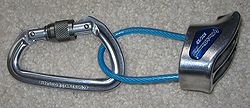
ATC-XP on locking carabiner
Belay devices serve as mechanical friction brake tools employed for rope control during belaying. Their primary function is to enable the easy locking of the rope to swiftly arrest a climber's descent in case of a fall. Various types of belay devices exist, with some also serving as descenders for controlled rope descent, as seen in activities like abseiling or rappelling.
These devices come in two designs: passive and active.
Passive belay devices depend on the belayer's braking hand and a carabiner to secure the rope. Sticht plates and Black Diamond Equipment's Air Traffic Controller (ATC) line are examples of passive devices. In the absence of a belay device, a Munter hitch on a carabiner can be employed as an improvised passive belay mechanism.
Active belay devices incorporate an integrated mechanism that independently locks the rope without requiring additional equipment. The Petzl GriGri is an instance of an active belay device. The GriGri's offset cam automatically locks the rope to catch a falling climber, functioning similar to a car's seatbelt locking to securely restrain a passenger.
Rappel devices (descenders)
These devices serve as friction brakes intended for descending ropes. Many belay devices can also function as descenders, but some descenders are not practical for belaying due to challenges in feeding rope or inadequate friction for securing a hard fall.
One common type is the "figure eight," sometimes referred to as the "figure of eight" or simply the "eight." While primarily used as a descender, it can also serve as a belay device when appropriate equipment is unavailable. Constructed from aluminum or steel in the shape of an "8," it comes in various designs. Its key advantage lies in its efficient heat dissipation. Notably, a square eight, more suitable for rappelling in rescue scenarios, outperforms the traditional 8.
Figure eight descenders facilitate rapid yet controlled rope descent. They are straightforward to set up and effectively manage friction-induced heat. However, they may cause rope twisting. Proper hand positioning—brake hand positioned parallel to the body—avoids rope twisting while ensuring controlled descent. Compared to tube-style belay/rappel devices, an 8 descender can accelerate rope wear due to the increased number of bends it introduces. Sport climbers may opt against figure eights due to the additional bulk they add to climbing gear. Nevertheless, ice climbers often prefer the figure 8 because of its ease of use with stiff or frozen ropes.
Another variation is the rescue eight, which includes "ears" or "wings" to prevent the rope from locking up, creating a larks head or girth hitch that could leave the rappeller stranded. These rescue eights are often crafted from steel rather than aluminum for added durability.
A different design, known as the rappel rack, consists of a 'U' shaped frame attached to the rappeller's harness. This frame holds multiple pivoting bars on the opposite side. The rope is threaded through the bars to adjust friction accordingly. Rappel racks accommodate variations in rope diameter and condition, as well as control the rate of descent. While uncommon in sport climbing, cavers frequently use racks for lengthy rappels due to their adjustable friction by adding or removing bars.
Ascenders
Ascenders are mechanical devices for ascending on a rope. They are also called Jumars, after a popular brand.
Jumars perform the same functionality as friction knots but less effort is needed to use them. A Jumar employs a cam which allows the device to slide freely in one direction but tightly grip the rope when pulled on in the opposite direction. To prevent a jumar from accidentally coming off the rope, a locking carabiner is used. The Jumar is first attached to the climber's harness by a piece of webbing or sling, and then the Jumar is clipped onto the rope and locked. Two ascenders are normally used to climb a fixed rope. For climbing a fixed rope attached to snow anchors on a steep slope, only one Jumar is used as the other hand is used for holding the ice axe.
Another type of ascender allows rope to feed in either direction, slowly, but locks up when pulled quickly. Such self-locking devices allow people to protect solo climbs because the amount of rope is automatically adjusted.
Sling
A sling or runner is an item of climbing equipment consisting of a tied or sewn loop of webbing that can be wrapped around sections of rock, hitched (tied) to other pieces of equipment or even tied directly to a tensioned line using a prusik knot, for anchor extension (to reduce rope drag and for other purposes), equalisation, or climbing the rope.
Daisy chain
A daisy chain is a strap, several feet long and typically constructed from one-inch tubular nylon webbing of the same type used in lengthening straps between anchor-points and the main rope. The webbing is bar tacked at roughly two-inch intervals (or, in the past, tied) to create a length of small loops for attachment. Unlike the use of similar devices in backpacking, daisy chains in technical rock climbing are expected to be of sufficient strength to be "load bearing". Daisy chain pockets however are not rated to full strength, and can only take static loads.
When clipped in, daisy chains should not be shortened by clipping in another pocket to the same carabiner. Failure of the pocket stitching results in the daisy chain disconnecting from the anchor, with potentially fatal consequences. If shortening the daisy chain when clipped in, in order to eliminate dangerous slack, a second carabiner should be used to connect to the anchor.
Though daisy chains are sometimes used by free climbers as a type of sling (a quick attachment used from harness directly to a belay anchor), and for ad hoc purposes similar to those of the backpacker, the canonical use for a daisy chain is in aid climbing, wherein the leader will typically attach one end to the harness, and the other to the top-most anchor placement (by carabiner or fifi hook), particularly after having ascended in étriers as high as possible. This allows the leader to hang from the daisy chain while preparing the next anchor placement. The closely spaced loops allow fine-tuning the length from harness to anchor, thereby allowing the best possible reach for the next placement.
Daisy chains should not be confused with étriers, also known as aiders, which are short ladders made in the same way, but with larger loops, also used in aid climbing, nor with load-limiting devices often known as screamers (from their first trade name) designed to simulate a dynamic belay.
Protection devices
Rock protection devices, referred to as "pro" or rock protection, offer a way to establish momentary anchor points on the rock surface. These tools can be grouped into two main categories: passive protection (like nuts) and active protection (such as spring-loaded camming devices or SLCDs). Passive protection functions as a constriction, relying on the rock's constrictions to prevent it from dislodging when pulled. In contrast, active protection translates a pulling force into outward pressure against the rock, enhancing its stability. The choice between these protection types hinges on the rock's characteristics, determining the most suitable option.
Nuts
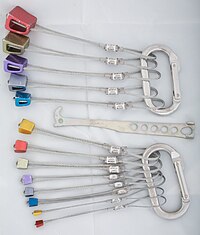
Typical nuts and a nut tool

Black Diamond Hexcentrics
Nuts are manufactured in many different varieties. In their simplest form, they are just a small block of metal attached to a loop of cord or wire. They are used by simply wedging them into narrowing cracks in the rock, then giving them a tug to set them. Nuts are sometimes referred to by the slang term, wires.
Hexes
Main article: hexes
Hexes are the oldest form of active protection. They consist of a hollow eccentric hexagonal prism with tapered ends, usually threaded with cord or webbing. They are frequently placed as a passive chock, but are more commonly placed in active camming positions. In the standard active placement, a fall causes the hex to twist in its placement exerting sideways force on the rock in which it is placed. They are manufactured by several firms, with a range of sizes varying from about 10mm thick to 100mm wide. Sides may be straight or curved.
Spring-loaded camming devices

An SLCD placed in a crack.
These consist of three or four cams mounted on a common axle or two adjacent axles, in such a way that pulling on the shaft connected to the axle forces the cams to spread further apart. The SLCD is used like a syringe, by pulling the cams via a "trigger" (a small handle) which forces them closer, inserting it into a crack or pocket in the rock, and then releasing the trigger. The springs make the cams expand and grip the rock face securely. A climbing rope may then be attached to the end of the stem via a sling and carabiner. SLCDs are typically designed to maintain a constant camming angle with the rock to ensure that the normal force provided by the cam lobes against the rock face will supply enough friction to hold a cam in equilibrium with the rock. These devices are also known as "friends" for example, as they are in the UK.
Tricams
A Tricam is a device that can be used as either active or passive protection. It consists of a shaped aluminium block attached to a length of tape (webbing). The block is shaped so that pulling on the tape makes it cam against the crack, gripping the rock tighter. Careful placement is necessary so that the "cam" does not loosen when not loaded. It is generally not as easy to place or remove as a SLCD but is much cheaper and lighter, and often is the only thing that will work in situations like quarry drill-holes and limestone pockets. The smaller sizes can work well in old piton scars, and can also be used passively as nuts.
Training equipment
Various items of equipment are employed during climbing-specific training.
Hangboards
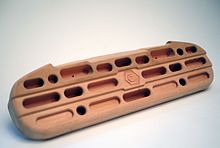
A wooden hangboard designed for increasing contact strength in rock climbers by Concept Climbing
A hangboard, also known as a fingerboard, is a wooden or resin board utilized by climbers to enhance their contact strength. This training tool targets the forearm muscles, tendons, and finger pulleys. It features an assortment of differently-sized pockets and edges that cater to various training approaches. These range from sizeable jug holds to minute crimp edges. When utilized effectively, hangboards can significantly enhance forearm and lock-off strength, primarily targeting muscles like the flexor digitorum profundus and flexor digitorum superficialis within the forearms. However, it's important to note that improper use can lead to injuries, often affecting the A1-4 pulleys or sections of the flexor carpi sheath connecting different FDS or FDP portions in the forearm.
Hangboards offer rock climbers the most effective means to bolster contact strength. By adhering to established training protocols and engaging in cyclical training, climbers can achieve remarkable strength gains over extended periods. These hangboards are typically installed above doorways or in locations that allow the user's body to suspend freely. Roof beams are particularly advantageous attachment points. Additionally, they are sometimes referred to as fingerboards.
Grip savers are compact devices designed to enhance the antagonist muscles that counteract the gripping action of the hand. These devices can help prevent the ligament injuries frequently encountered by climbers.
Campus boards consist of horizontal rungs attached to an inclined surface, enabling climbers to ascend and descend without using their feet. Correct usage of campus boards can enhance finger strength and the often-referenced "contact strength".
A Bachar ladder is crafted by suspending large-diameter PVC piping on webbing, and climbers ascend it without utilizing their feet. This exercise aids in bolstering overall upper body strength as well as core strength.
Specialized clothing
In the early days of climbing, many would have considered specialised clothing to be cheating. In fact, the first climbers considered an untucked shirt or unbuttoned sport jacket a sign of weakness. Several climbers even chose to climb barefoot, an act that modern climbers would find amazing. In the 1980s and early 1990s, the trend was to wear tight, brightly coloured clothes often made from Spandex. The trend, now, is to wear looser-fitting clothing. Trousers can be tailored to prevent them from restricting movement by adding features such as articulated knee joints and diamond crotch.
Helmet

A Petzl Elios climbing helmet designed for caving and mountaineering
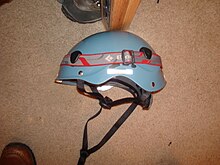
Black Diamond Equipment Half Dome climbing helmet
The climbing helmet is a piece of safety equipment that primarily protects the skull against falling debris (such as rocks or dropped pieces of protection) and impact forces during a fall. For example, if a lead climber allows the rope to wrap behind an ankle, a fall can flip the climber over and consequently impact the back of the head. Furthermore, any effects of pendulum from a fall that have not been compensated for by the belayer may also result in head injury to the climber. The risk of head injury to a falling climber can be further significantly mitigated by falling correctly.
Climbers may decide whether to wear a helmet based on a number of factors such as the type of climb being attempted, concerns about weight, reductions in agility, added encumbrances, or simple vanity. Additionally, there is less incentive to wear a helmet in artificial climbing environments like indoor climbing walls (where routes and holds are regularly maintained) than on natural multi-pitch routes or ice climbing routes (where falling rocks and/or ice are likely).
Climbing shoes
Specifically designed foot wear is usually worn for climbing. To increase the grip of the foot on a climbing wall or rock face due to friction, the shoe is soled with a vulcanized rubber layer. Usually, shoes are only a few millimetres thick and fit very snugly around the foot. Stiffer shoes are used for "edging", more compliant ones for "smearing". Some have foam padding on the heel to make descents and rappels more comfortable. Climbing shoes can be re-soled which decreases the frequency that shoes need to be replaced.
Belay gloves
A belay glove is a glove constructed from either leather or a synthetic substitute, is used to protect the hands when belaying, and is especially useful if using a classic or body belay. They are also very useful for controlling the belay with single, lead ropes that are 9.5 mm or smaller. Ultimately, belay gloves can lessen the possibility of rope burn and the subsequent involuntary release of the rope.
Miscellaneous equipment
Tape
Medical tape is useful to both prevent and repair minor injuries. For example, tape is often used to fix flappers. Many climbers use tape to bind fingers or wrists to prevent recurring tendon problems. Tape is also highly desirable for protecting hands on climbing routes that consist mostly of repeated hand jamming.
"Tape" can also refer to nylon webbing.
Chalk
Chalk is used by nearly all climbers to absorb problematic moisture, often sweat, on the hands. Typically, chalk is stored as a loose powder in a special chalk bag designed to prevent spillage, most often closed with a drawstring. This chalk bag is then hung by a carabiner from the climbing harness or from a simple belt worn around the climber's waist . This allows the climber to re-chalk during the climb with minimal interruption or effort. To prevent excess chalking (which can actually decrease friction), some climbers will store their chalk in a chalk ball, which is then kept in the chalk bag. A chalk ball is a very fine, mesh sack that allows chalk release with minimum leakage when squeezed so that the climber can control the amount of chalk on the hands.
Chalk is most frequently white, and the repeated use of holds by freshly-chalked hands leads to chalky build-up. While this isn't a concern in an indoor gym setting, white chalk build-up on the natural rock of outdoor climbs is considered to be an eyesore at best, and many consider it a legitimate environmental/conservation concern. In the United States, the Bureau of Land Management advocates the use of chalk that matches the color of the native rock.Several popular climbing areas, like Arches National Park have banned white chalk, instead allowing the use of rock-colored chalk. Garden of the Gods has gone further, banning the use of calcium carbonate (the most common chalk) outright, requiring the use of a rock-colored substitute. A handful of companies make colored chalk or a chalk substitute
Because of an assorted geography, experience visits in India are of various sorts. These will enable you to get over the weariness prompted by the unidimensional city life. At whatever point you need a one of a kind and sagacious excursion, go for such exciting commitment as they will influence you to feel glad. You could appreciate them alone,with companions or like a fun family excursion. There are numerous experience goals in India, and you can go for tourist
Ladakh: The harsh territory and regular magnificence of Ladakh have made it a splendid goal for enterprise darlings. With a normal rise of more than 10000 feet above ocean level, Ladakh has a cool bone-dry atmosphere.
Rishikesh: This hallowed place is situated in the territory of Uttarakhand, and is another outstanding spot to enjoy excite prompting sports like boating, shake climbing, rappelling and the sky is the limit from there. Rishikesh can be gone to in any month as the climate here is constantly wonderful.
Lonavala: It is around 65 km from Pune, and is a prevalent slope town. With a direct elevation of around 2050 feet, the geology here isn't excessively rough, and the climate does not wind up extraordinary. Hot air swelling is famous here. 
Kamshet: This goal lies in the Sahyadri Ranges; henceforth its height is direct. Indeed, even in the pinnacle of winters, the temperature once in a while drops to beneath 10 degree Celsius, making it a pleasant place to appreciate the season. Paragliding is done here from October to April.
Kolad: Another astonishing spot to savor exciting game of boating, this little town lies on the banks of the Kundalika River. Far from urban focuses and drenched in quietness, it is a perfect escape in the event that you need to unwind.
Goa: Those who need to have an energizing time along the oceans should come to Goa. It is an ideal place to enjoy some fantastic and energizing water sports.
Aside from the previously mentioned places for experience trips in India, there are swarms of different locales too to design exciting endeavors.
With a plenty of energizing commitment in the nation, such fervor creating sports will undoubtedly keep picking up esteem.
Treks: You can trek at various goals like Ladakh, Uttarakhand, Sikkim, Himachal Pradesh and Kashmir.
Engine Bike Expeditions: Biking stumbles on the Leh-Manali expressway and through South and West India are facilitated by heaps of movement organizations as they are profoundly respected.
Waterway Rafting: The province of Uttarakhand and the town of Kolad are two prime goals for boating.
Hot Air Ballooning: Jaipur in Rajasthan and Lonavala close Mumbai are the two most looked for after spots for hot air swelling. Both these goals have climate conditions, which are good for the commitment.
Scuba Diving: To see the submerged world from very close, travel to Andaman and Nicobar Islands, the province of Goa or the town of Murudeshwar in Karnataka. You will get scuba preparing from PADI guaranteed teachers at all these destinations previously you take off to the ocean.
Untamed life Safari: The nation has heaps of secured territories like Corbett, Bandhavgarh, Kanha and Pench national parks, where natural life safaris can be benefited.
Outdoors: You can camp wherever there are immaculate environs like slopes and woods. There are numerous such places in Uttarakhand, West Bengal, Rajasthan, Karnataka and Himachal Pradesh, which you can pick.
designed to comply with these environmental conservation measures.


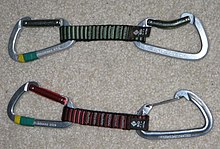













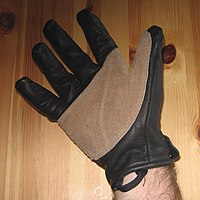






Very usefull for all adventurers.
ReplyDelete